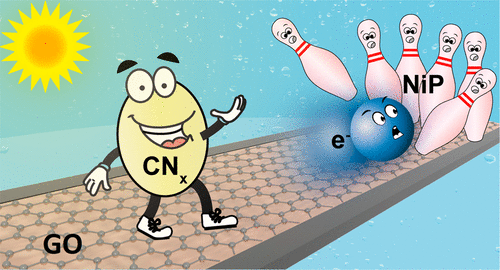当前位置:
X-MOL 学术
›
ACS Catal.
›
论文详情
Our official English website, www.x-mol.net, welcomes your feedback! (Note: you will need to create a separate account there.)
Interfacial Engineering of a Carbon Nitride–Graphene Oxide–Molecular Ni Catalyst Hybrid for Enhanced Photocatalytic Activity
ACS Catalysis ( IF 12.9 ) Pub Date : 2018-06-12 00:00:00 , DOI: 10.1021/acscatal.8b01969 Hatice Kasap 1 , Robert Godin 2 , Chiara Jeay-Bizot 2 , Demetra S. Achilleos 1 , Xin Fang 1 , James R. Durrant 2 , Erwin Reisner 1
ACS Catalysis ( IF 12.9 ) Pub Date : 2018-06-12 00:00:00 , DOI: 10.1021/acscatal.8b01969 Hatice Kasap 1 , Robert Godin 2 , Chiara Jeay-Bizot 2 , Demetra S. Achilleos 1 , Xin Fang 1 , James R. Durrant 2 , Erwin Reisner 1
Affiliation

|
Carbon nitrides (CNx) are a promising class of photocatalyst for fuel and chemical synthesis as they are nontoxic and readily synthesized at a low cost. This study reports the enhanced photocatalytic activity for simultaneous alcohol oxidation and proton reduction when graphene oxide (GO) or reduced graphene oxide (RGO) is employed as an interlayer between a cyanamide-functionalized melon-type carbon nitride (NCNCNx) and a phosphonated Ni-bis(diphosphine) H2-evolution catalyst (NiP). Introduction of the GO/RGO enhanced the activity three times, reaching a specific activity of 4655 ± 448 μmol H2 (g NCNCNx)−1 h–1 with a NiP-based turnover frequency of 116 ± 3 h–1. Mechanistic studies into this closed photoredox system revealed that the rate of electron extraction from NCNCNx is rate limiting. GO/RGO is commonly employed to improve the electron transfer dynamics on nanosecond time scales, but time-resolved photoluminescence and transient absorption spectroscopy reveal that these properties are not significantly affected in our NCNCNx-GO hybrid on fast time scales (<0.1 s). However, long-lived “trapped-electrons” generated upon photoexcitation of NCNCNx in the presence of organic substrates are shown by photoinduced absorption spectroscopy to be quenched faster with GO/RGO, supporting that GO/RGO improves electron transfer from NCNCNx to NiP on time scales >0.1 s. The absorption profile of NiP in the presence of different GO loadings reveals that GO acts as a conductive interfacial “binder” between NiP and NCNCNx. The enhancement in activity therefore does not primarily arise from changes in the photophysics of the NCNCNx, but rather from GO/RGO enabling better electronic communication between NCNCNx and NiP.
中文翻译:

碳氮化物-氧化石墨烯-分子镍催化剂杂化体的界面工程增强了光催化活性
碳氮化物(CN x)是一种有前景的燃料和化学合成光催化剂,因为它们无毒且易于以低成本合成。这项研究报告了当使用氧化石墨烯(GO)或还原的氧化石墨烯(RGO)作为氰胺官能化的瓜型氮化碳(NCN CN x)和膦酸酯化的中间层时,增强的光催化活性,可同时进行醇氧化和质子还原Ni-双(二膦)H 2析出催化剂(NiP)。GO / RGO的引入使活性提高了三倍,比活性达到4655±448μmolH 2(g NCN CN x)-1h –1,基于NiP的周转频率为116±3 h –1。对这种封闭的光氧化还原系统的机械研究表明,从NCN CN x提取电子的速率是速率限制的。GO / RGO通常用于在纳秒级的时间尺度上改善电子传输动力学,但是时间分辨的光致发光和瞬态吸收光谱表明,在我们的NCN CN x -GO杂化体中,这些特性在快速的时间尺度上(<0.1 s并没有显着影响))。但是,NCN CN x的光激发会产生长寿命的“俘获电子”光诱导吸收光谱法显示,在有机底物存在下,GO / RGO可以更快地淬灭,证明GO / RGO可以在> 0.1 s的时间尺度上改善从NCN CN x到NiP的电子转移。在不同GO负载下NiP的吸收曲线表明,GO充当NiP和NCN CN x之间的导电界面“粘合剂” 。因此,活动的增强主要不是由NCN CN x的光物理变化引起的,而是由GO / RGO引起的,从而可以在NCN CN x之间实现更好的电子通信。和NiP。
更新日期:2018-06-12
中文翻译:

碳氮化物-氧化石墨烯-分子镍催化剂杂化体的界面工程增强了光催化活性
碳氮化物(CN x)是一种有前景的燃料和化学合成光催化剂,因为它们无毒且易于以低成本合成。这项研究报告了当使用氧化石墨烯(GO)或还原的氧化石墨烯(RGO)作为氰胺官能化的瓜型氮化碳(NCN CN x)和膦酸酯化的中间层时,增强的光催化活性,可同时进行醇氧化和质子还原Ni-双(二膦)H 2析出催化剂(NiP)。GO / RGO的引入使活性提高了三倍,比活性达到4655±448μmolH 2(g NCN CN x)-1h –1,基于NiP的周转频率为116±3 h –1。对这种封闭的光氧化还原系统的机械研究表明,从NCN CN x提取电子的速率是速率限制的。GO / RGO通常用于在纳秒级的时间尺度上改善电子传输动力学,但是时间分辨的光致发光和瞬态吸收光谱表明,在我们的NCN CN x -GO杂化体中,这些特性在快速的时间尺度上(<0.1 s并没有显着影响))。但是,NCN CN x的光激发会产生长寿命的“俘获电子”光诱导吸收光谱法显示,在有机底物存在下,GO / RGO可以更快地淬灭,证明GO / RGO可以在> 0.1 s的时间尺度上改善从NCN CN x到NiP的电子转移。在不同GO负载下NiP的吸收曲线表明,GO充当NiP和NCN CN x之间的导电界面“粘合剂” 。因此,活动的增强主要不是由NCN CN x的光物理变化引起的,而是由GO / RGO引起的,从而可以在NCN CN x之间实现更好的电子通信。和NiP。



























 京公网安备 11010802027423号
京公网安备 11010802027423号